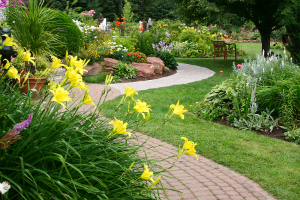Perched atop a prestige apartment block, these balcony gardens are ultra-modern
Story: Peter Fudge
Photos: Sam McAdam
I remember this as a really, really challenging job, not due to the hardship of the site but because of the surroundings — this penthouse possessed one of the world’s most magnificent views. The penthouse at East Circular Quay has four balconies, which overlook the Opera House, Sydney Harbour and the Royal Botanic Gardens, and its position could be said to capture the essence of Sydney. The pressure was on to get the design absolutely right because of this magnificent setting.
I was aware that the owner had moved from a large garden and therefore might want something that would look ‘pretty’, but as the design came close to completion it had become clear to me in which direction I should go. I was able to convince the client that, in this situation, the numerous focal points were all around us and that we should not try to compete with them. Instead, the design should highlight them. Restraint was to be the key to this design. Fortunately, the client appreciated this direction.
There were technical difficulties, however. Plant selection for these high-rise balcony gardens was critical — the balconies are covered by eaves, so rainfall is restricted, while for half the day they receive no sun and for the other half it is blazingly hot and bright, due to the aspect.
Both west-facing courtyards were lined with contemporary charcoal-coloured pots. These tall pots were planted with the stunning aqua-coloured agaves (Agave attenuata), picking up the colour of the harbour and framing the postcard view. This succulent is a native of Mexico, from the mountains. Many agaves have spines but this one does not, making it suitable as a plant in this situation. It is drought-tolerant and will not mind the midday heat.
To echo the stainless-steel used in the building, we built a stainless-steel feature wall against a frosted glass panel. This broke up the space and formed a structure in which we could affix two contemporary aqua wall fountains. On another stainless-steel wall we suspended stone candle holders planted with succulents — Kalanchoe species. A lot of succulents aren’t fully identified at nurseries, but this one has silver, oval-shaped leaves that have a trailing habit and pretty pink flowers.
On the eastern side of the two courtyards we repeated the pots of Agave attenuata except this time we also used stainless-steel troughs planted with Spartan juniper (Juniperus virginiana ‘Spartan’) to provide screening from the neighbours. This juniper was also chosen for its hardiness and its ability to withstand balcony conditions.
For colour and dramatic foliage, purple-leafed bromeliads (Vriesea imperialis) in black pots line a narrow section of one east-facing balcony, their leaves picking up the shape of the Opera House beyond. Vriesea imperialis is a wonderful bromeliad species that grows to approximately one-and-a-half metres high. The rosettes of leaves need bright sun in order to develop the purple colouration, but there is more than enough sunlight on this balcony. After some years they should flower in summer; the inflorescence is raised high above the foliage and is spectacular and long lasting.
Bromeliads are an unusual family of plants. Many species are epiphytes — they grow high on trees and absorb their nutrients from moisture in the air. They are also tough and will survive balcony life.
This was a garden where restraint and continuity were used to frame — in fact, to emphasise — the magnificent views around this unique location. The choice of materials and plants was critical as a balance to the backdrops behind.
About the author: Peter Fudge of Peter Fudge Garden Design is a Sydney-based landscape designer. The story was taken from Peter Fudge Gardens, published by Hardie Grant Books.




